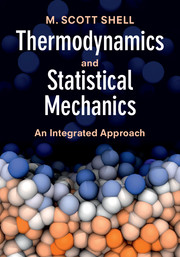Crossref Citations
This Book has been
cited by the following publications. This list is generated based on data provided by Crossref.
Jalal, Taghreed A.
Bettahalli, N. M. Srivatsa
Le, Ngoc Lieu
and
Nunes, Suzana P.
2015.
Hydrophobic Hyflon AD/Poly(vinylidene fluoride) Membranes for Butanol Dehydration via Pervaporation.
Industrial & Engineering Chemistry Research,
Vol. 54,
Issue. 44,
p.
11180.
Long, Andrew W.
Phillips, Carolyn L.
Jankowksi, Eric
and
Ferguson, Andrew L.
2016.
Nonlinear machine learning and design of reconfigurable digital colloids.
Soft Matter,
Vol. 12,
Issue. 34,
p.
7119.
Grazioli, D.
Magri, M.
and
Salvadori, A.
2016.
Computational modeling of Li-ion batteries.
Computational Mechanics,
Vol. 58,
Issue. 6,
p.
889.
Knobbe, Edwin
and
Roekaerts, Dirk
2017.
Coherent Application of a Contact Structure to Formulate Classical Non-Equilibrium Thermodynamics.
Modern Mechanical Engineering,
Vol. 07,
Issue. 01,
p.
8.
Gálisová, Lucia
2017.
Magnetization plateau as a result of the uniform and gradual electron doping in a coupled spin-electron double-tetrahedral chain.
Physical Review E,
Vol. 96,
Issue. 5,
Simon, Cory M.
Braun, Efrem
Carraro, Carlo
and
Smit, Berend
2017.
Statistical mechanical model of gas adsorption in porous crystals with dynamic moieties.
Proceedings of the National Academy of Sciences,
Vol. 114,
Issue. 3,
Gianinetti, Alberto
2017.
An Account of Thermodynamic Entropy.
p.
190.
Demtröder, Wolfgang
2017.
Mechanics and Thermodynamics.
p.
183.
Ferguson, Andrew L.
2017.
BayesWHAM: A Bayesian approach for free energy estimation, reweighting, and uncertainty quantification in the weighted histogram analysis method.
Journal of Computational Chemistry,
Vol. 38,
Issue. 18,
p.
1583.
Wang, J.
and
Ferguson, A. L.
2018.
Nonlinear machine learning in simulations of soft and biological materials.
Molecular Simulation,
Vol. 44,
Issue. 13-14,
p.
1090.
Sturluson, Arni
Huynh, Melanie T.
Kaija, Alec R.
Laird, Caleb
Yoon, Sunghyun
Hou, Feier
Feng, Zhenxing
Wilmer, Christopher E.
Colón, Yamil J.
Chung, Yongchul G.
Siderius, Daniel W.
and
Simon, Cory M.
2019.
The role of molecular modelling and simulation in the discovery and deployment of metal-organic frameworks for gas storage and separation.
Molecular Simulation,
Vol. 45,
Issue. 14-15,
p.
1082.
Rocha, Brunno
Paul, Sanjib
and
Vashisth, Harish
2020.
Role of Entropy in Colloidal Self-Assembly.
Entropy,
Vol. 22,
Issue. 8,
p.
877.
Svolos, Lampros
Bronkhorst, Curt A.
and
Waisman, Haim
2020.
Thermal-conductivity degradation across cracks in coupled thermo-mechanical systems modeled by the phase-field fracture method.
Journal of the Mechanics and Physics of Solids,
Vol. 137,
Issue. ,
p.
103861.
Khanna, Vikram
Monroe, Jacob I.
Doherty, Michael F.
and
Peters, Baron
2020.
Performing solvation free energy calculations in LAMMPS using the decoupling approach.
Journal of Computer-Aided Molecular Design,
Vol. 34,
Issue. 6,
p.
641.
Volchenkov, Dimitri
2021.
Infinite Ergodic Walks in Finite Connected Undirected Graphs.
Entropy,
Vol. 23,
Issue. 2,
p.
205.
Serpelloni, Mattia
Arricca, Matteo
Bonanno, Claudia
and
Salvadori, Alberto
2021.
Modeling cells spreading, motility, and receptors dynamics: a general framework.
Acta Mechanica Sinica,
Vol. 37,
Issue. 6,
p.
1013.
Alvarado, Walter
Moller, Joshua
Ferguson, Andrew L.
and
de Pablo, Juan J.
2021.
Tetranucleosome Interactions Drive Chromatin Folding.
ACS Central Science,
Vol. 7,
Issue. 6,
p.
1019.
Cai, Guorui
Yin, Yijie
Xia, Dawei
Chen, Amanda A.
Holoubek, John
Scharf, Jonathan
Yang, Yangyuchen
Koh, Ki Hwan
Li, Mingqian
Davies, Daniel M.
Mayer, Matthew
Han, Tae Hee
Meng, Ying Shirley
Pascal, Tod A.
and
Chen, Zheng
2021.
Sub-nanometer confinement enables facile condensation of gas electrolyte for low-temperature batteries.
Nature Communications,
Vol. 12,
Issue. 1,
Oladimeji, Enock
Etim, Emmanuel
and
Ojo, Moses
2022.
The thermodynamic properties of interstellar isomers with 3 atoms.
Advances in Space Research,
Vol. 70,
Issue. 11,
p.
3745.
Assaf, Eli I.
Liu, Xueyan
Lin, Peng
Erkens, Sandra
Nahar, Sayeda
and
Mensink, Liz I.S.
2023.
Studying the impact of phase behavior in the morphology of molecular dynamics models of bitumen.
Materials & Design,
Vol. 230,
Issue. ,
p.
111943.



